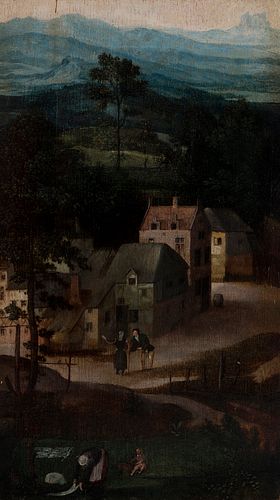BRUEGHEL family; Second half of the sixteenth century. "Landscape." Oil on oak panel. Cradled
Lot 87
About Seller
Setdart Auction House
Carrer Aragó 346
Barcelona
Spain
Setdart Subastas was born in 2004 and is currently the first online art auction in Spain with solidity, prestige and reliability guaranteed by our more than 60,000 users. Setdart has a young, dynamic and enterprising team ready to successfully manage the purchase and sale of art works through custom...Read more
Estimate:
EUR€80,000 - EUR€90,000
$86,021.51 - $96,774.19
Absentee vs Live bid
Two ways to bid:
- Leave a max absentee bid and the platform will bid on your behalf up to your maximum bid during the live auction.
- Bid live during the auction and your bids will be submitted real-time to the auctioneer.
Bid Increments
| Price | Bid Increment |
|---|---|
| EUR€0 | EUR€10 |
| EUR€200 | EUR€25 |
| EUR€500 | EUR€50 |
| EUR€1,000 | EUR€100 |
| EUR€3,000 | EUR€200 |
| EUR€5,000 | EUR€500 |
| EUR€10,000 | EUR€1,000 |
| EUR€20,000 | EUR€2,000 |
| EUR€50,000 | EUR€5,000 |
About Auction
By Setdart Auction House
Oct 20, 2021
Set Reminder
2021-10-20 07:30:00
2021-10-20 07:30:00
America/New_York
Bidsquare
Bidsquare : OLD MASTERS
https://www.bidsquare.com/auctions/setdart-auction-house/old-masters-7700
Setdart Auction House sofia@setdart.com
Setdart Auction House sofia@setdart.com
- Lot Description
BRUEGHEL family; Second half of the sixteenth century. "Landscape." Oil on oak panel. Cradled Presents frame following ancient models. Measures: 36 x 18 cm; 70 x 54 cm (frame). With a relatively high horizon, where the sky composed by a gradation of blue tonalities, hardly occupies space, the author, grants the protagonism of the scene to the landscape. A costumbrist view conceived through successive planes. In the center of the scene, two figures hold a conversation. However, their small dimensions indicate the artist's interest in capturing the landscape. By theme and style it is very close to the painting developed by the important dynasty of Dutch painters, the Brueghels. The meticulous and expressive drawing characterizing the characters and their vivid behaviors is combined with a freer brushstroke in the representation of the landscape, also splendid, working in different levels of depth, assuming bluish tones in the horizon. During the 17th century, the Flemish school experienced great splendor and artistic development. The strategic location of the area, and the presence of one of the most important ports of the time, gave rise to the proliferation of a new social class, composed of merchants, who possessed a large capita. This new society enjoyed the advantages of their economic position, however, they did not have the aristocratic titles, so they began a race for social position through culture. In addition, due to the rupture with Rome and the iconoclastic tendency of the reformed Church, paintings with religious themes ended up being eliminated as a decorative complement with a devotional purpose, and mythological stories lost their heroic and sensual tone, in accordance with the new society. Thus, portraits, landscapes and animals, still life and genre painting were the thematic formulas that became valuable in their own right and, as objects of domestic furniture - hence the small size of the paintings - were acquired by individuals of almost all classes and social strata: The tandem formed by Peter Paul Rubens and Jan Brueghel the Elder, the one composed by Hendrick van Balen and Jan Brueghel de Velours, or the one comprising the figures of Jan Brueghel the Younger and Pieter Van Avont, are proof of the success of this type of contributions in 17th century Flanders.
- Shipping Info
-
In-house shipping available. Please inquire at admin@setdart.com.
-
- Buyer's Premium



 EUR
EUR CAD
CAD AUD
AUD GBP
GBP MXN
MXN HKD
HKD CNY
CNY MYR
MYR SEK
SEK SGD
SGD CHF
CHF THB
THB









